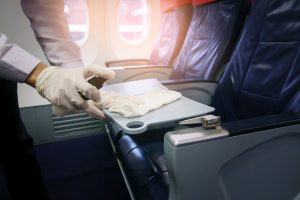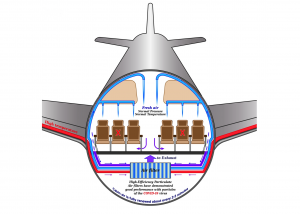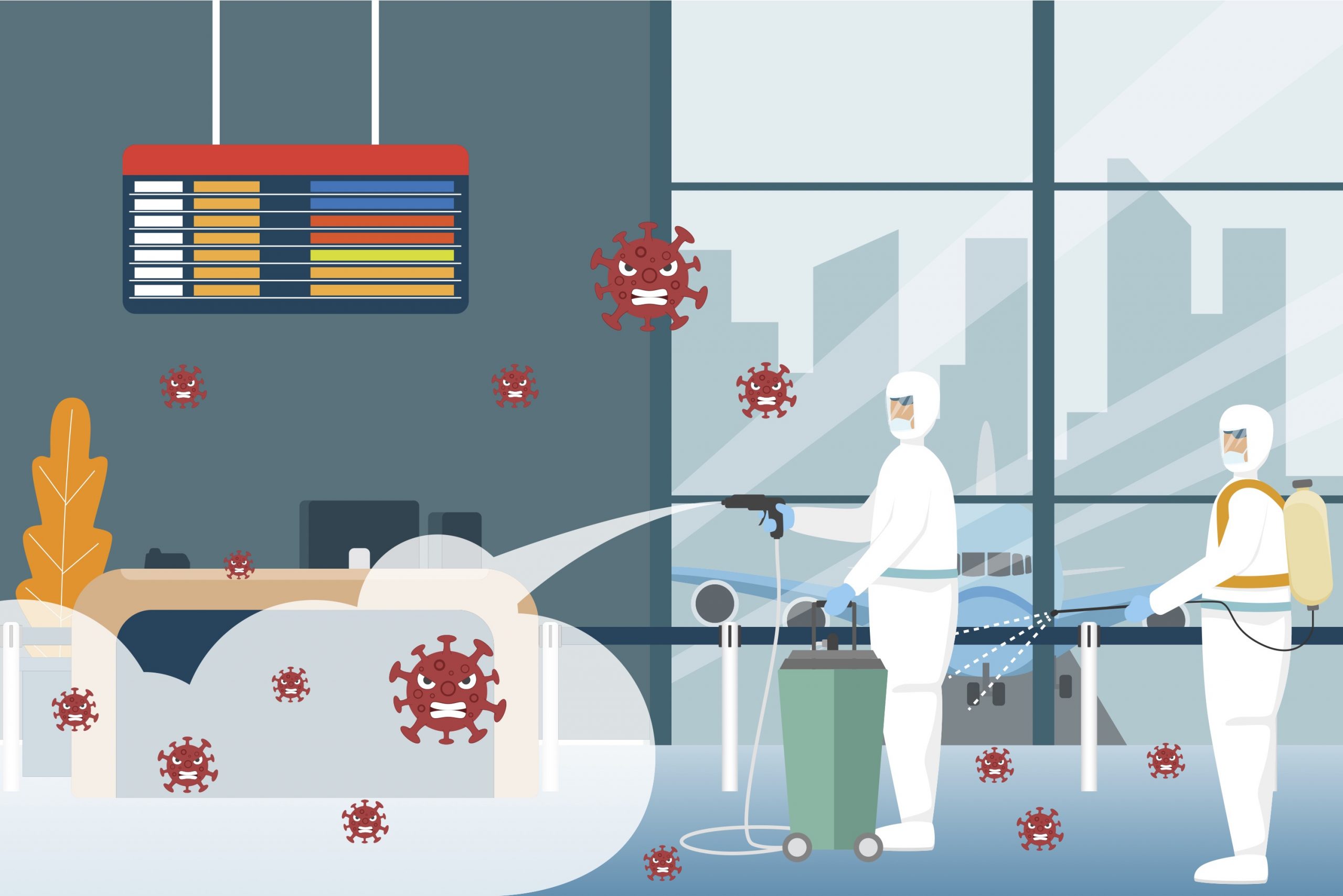The cleanliness of airplanes has been a much-discussed topic well before the COVID-19 pandemic. The pandemic, however, has put airline cleaning practices under a microscope as the public tries to determine whether or not it is safe to fly. If you are considering flying on the heels of the pandemic, you probably have questions about what airlines are doing to keep you safe. Keep reading to find out. We will also give you some tips on what you can do reduce your risk of getting sick on a flight.
In this post, we’ll cover:
- Updates that airlines have made to their airplane cleaning procedures
- Provide information on what health experts are saying about how safe it is to fly during the pandemic
- Detail the changes airlines have made onboard to protect their customers and crew
Improved Aircraft Cleaning Procedures during the COVID-19 Pandemic
Cabin Cleaning
Pre-pandemic, airplane cleaning practices generally consisted of a quick cabin walk by airline employees between flights to pick up trash and clean up any liquid spills. Bathrooms might have gotten a quick wipe down, particularly on longer haul flights. Deeper cabin cleaning and disinfecting was generally limited to when the airplane was pulled out of service for scheduled maintenance or when mandated by a local government.
The pandemic, however, has forced airlines to improve their cleaning procedures in order to keep their crew and the public safe. For instance, American Airlines is touting themselves as the first airline to hold a GBAC STAR Accreditation from the Global Biorisk Advisory Council, which (among other things) means that AA has “established and maintained a cleaning, disinfection, and infectious disease prevention program to minimize risks associated with infectious agents like the novel coronavirus.” More details about the GBAC STAR Accreditation can be found here. American also says that they deep clean high-touch aircraft surfaces like tray tables, seat belts, armrests, window shades, doors and overhead bin handles and they also offer hand sanitizer wipes onboard.

Airlines are cleaning high touch cabin surfaces, like tray tables, more frequently due to COVID 19
Similarly, Delta’s Delta Clean initiative has each plane getting a full cabin sanitization every night, and high touch cabin parts are sanitized before every flight. We have found that all US based airlines have made similar updates to their cabin cleaning procedures. More details can be found on the airlines’ websites.
Cabin Air Quality – HEPA Filtration Explained
Air quality is another area of concern, particularly when it comes to the potential to spread viruses like COVID-19 through airborne particles. This has been a point of emphasis for airlines and aircraft manufacturers long before the coronavirus pandemic. Except for some very small aircraft, all commercial airplanes have been built with HEPA (High-Efficiency Particle Filters) air filtration systems since the 1980’s. HEPA equipped airplanes clean the cabin air similar to how operating rooms are kept sterile, by minimizing the crossover of air streams. Filtered air is pumped through the ceiling at a high speed and sucked out again at the floor level. Check out this video from United that demonstrates how the HEPA system works on an aircraft.
The EPA says that HEPA filters remove 99.97% of all airborne particles, and a study done by NASA concluded that the effectiveness of HEPA filters held up against COVID-19 virus particles .
American, Delta and United all say that their entire mainline fleets are equipped with HEPA cabin filters, and many have worked diligently to equip their regional fleets (such as American Eagle and United Express) as well. Concerned about whether or not your aircraft will be equipped with a HEPA filtration system? We suggest calling your airline to ask them directly.

How HEPA air filters work in aircraft cabins
Changes to the Boarding Process and Onboard Experience
Face Coverings are Required
Improved aircraft cleaning isn’t the only thing being done to keep passengers safe while flying during the pandemic. The Transportation Security Administration (TSA) is continuing to require passengers, crew and staff to wear face coverings during check-in, boarding and throughout the flight. Enforcement may differ some from airline to airline or even crew to crew. Still, if you plan on flying, assume that you will be wearing a face covering throughout your journey. Airlines are likely to not let you fly if you are not wearing a mask, and you may even face a fine if you refuse to cover up.
There are some exceptions to the face covering requirement though, depending on which airline you are flying on. Young children or people with medical conditions that prevent them from wearing a mask may be exempt. If needed, you should check with your specific airline to confirm that they offer the exemption, as not all do. Also, airlines will allow passengers to remove their mask during flight while they are eating and drinking.
Blocked Middle Seats
Of course, there has been a lot of conversation around airlines blocking middle seats. As of April of this year, no US based airlines are blocking middle seats (Delta was last airline to block all middle seats). But did blocking middle seats have any real impact on the spread of coronavirus on planes? A paper published by MIT professor and aviation safety expert Arnold Barnet says that empty middle seats decreases the risk of contracting coronavirus by a factor of 1.8. This means that if all seats on an aircraft are sold, the probability of contracting COVID-19 from another passenger is 1-in-4,300. If middle seats are left empty, the probability goes down to 1-in-7,700. That is certainly an improvement, but perhaps not the drastic improvement that you might expect based on recent media coverage.
It makes sense that empty middle seats don’t have a larger impact on virus spread on an otherwise full plane, given that the average pitch on US carriers is only 31 inches, well below the six foot social distancing standard. In order to maintain the standard 6 foot social distancing on an airplane, we estimate that airlines would have to only seat people in every 4th row, and even then only in the window seats. No airline could stay in business with that model.
Inflight Food & Beverage Service
There have also been some big changes to the food and beverage service offered in flight. United, for example, has made some fairly drastic cuts with no service of any kind in Economy on flights under 1 hour. For flights over 1 hour, Economy passengers will get complimentary non-alcoholic beverages with beer, wine and hard seltzer available for purchase. Snacks are only provided to Economy passengers for flights over 2 hours and 20 minutes. United is now back to offering complimentary beer and wine on all flights in premium cabins. Southwest, who suspended all food and beverage service early in the pandemic, has reintroduced water and snack mix on flights over 250 miles.
For a rundown of the current onboard food and beverage service for each US based airlines, check out this article over at The Points Guy. And of course, airlines will still allow you to bring your own food and non-alcoholic beverages onboard.
Our Advice on Staying Safe While Flying During the Pandemic
- Book flights for early in the morning when airplanes are likely to be at their cleanest after overnight deep cleaning.
- Take advantage of the tools offered by airlines for a contactless check-in and boarding process, like this one from American Airlines
- Eat something before you head to the airport so that you can avoid crowded airport restaurants. For longer flights, bring your own snacks so that you won’t need to interact with crews to purchase something onboard.
- Bring sanitizing wipes to wipe down high touch areas around your seat. Things like seat belt buckles, tray tables, air outlets and arm rests are touched by almost every passenger.
- Bring hand sanitizer, but don’t be afraid to ask the crew for some if you forgot yours. Most airlines are stocking planes with hand sanitizer for crew and passengers.
- Don’t fly if you have a fever or experiencing any other symptoms of COVID-19
- Bring a comfortable mask that you can wear for your flight plus the time you will spend at the airport.
- If traveling with young children, be sure that they are comfortable wearing a mask for long durations of time.
What the Experts are Saying about the Safety of Flying During the Pandemic
We are not medical experts, so we cannot tell you if it is safe for you personally to fly. Below is a collection of articles written by medical and aviation safety experts on the subject. If you still have concerns about how safe it is for you to fly, please consult with your doctor. Also, if you find yourself in the situation where you have booked a flight but later decide that you do not want to travel, look for our upcoming article “Airline COVID-19 Refund Requirements and Policies”.
- MIT: How Safe is Air Travel?
- CDC: Travel During COVID-19
- Mayo Clinic: Coronavirus Travel Advice
- World Health Organization: Coronavirus Disease (COVID-19) Travel Advice
- JAMA Network, a peer reviewed medical journal: Risk of COVID-19 During Air Travel
Trip Tiger is here if you need help dealing with airlines after a bad flight experience. Requesting a refund for a canceled flight? Seeking compensation for a flight delay or damaged baggage? Maybe you just want to let the airline or DOT know about a less than stellar customer experience. Head over to our home page to get started.




Great content! Keep up the good work!